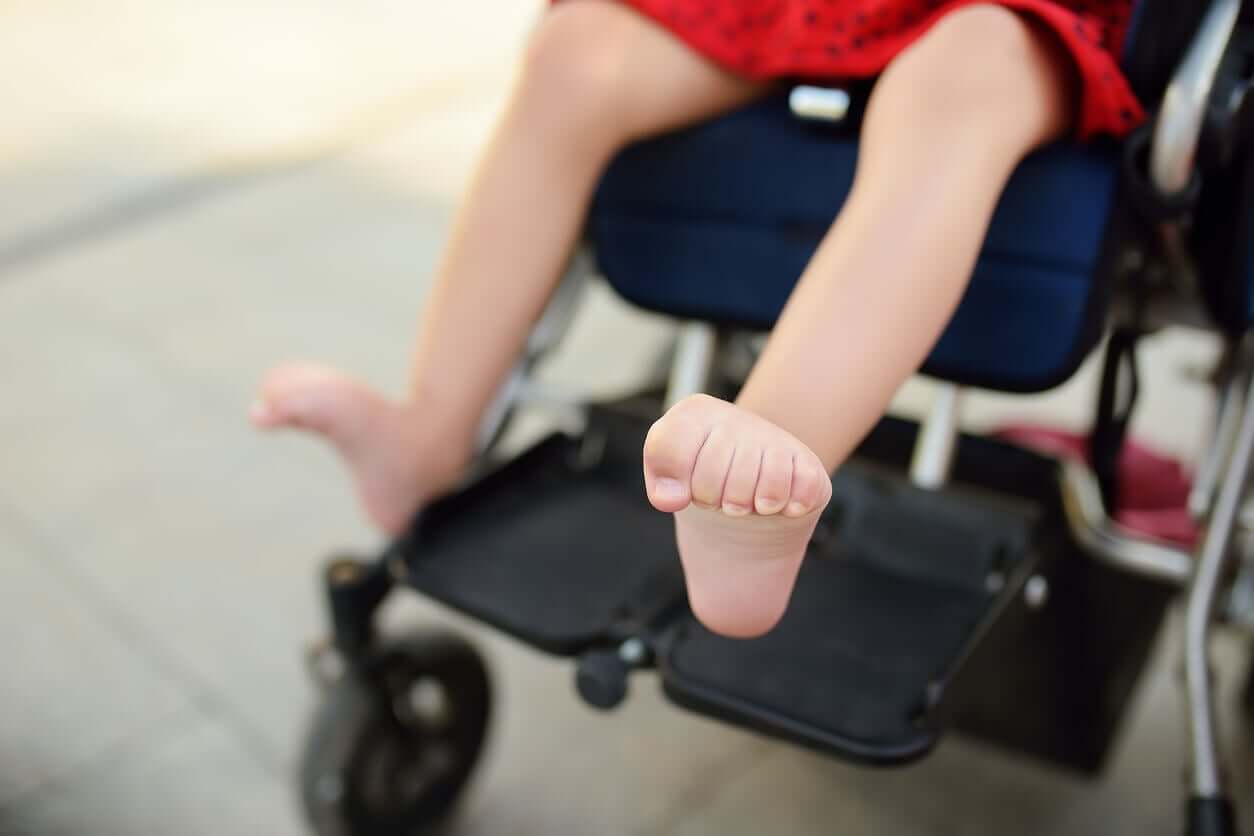Hypertonia in Babies: Symptoms, Causes and Treatment

At birth, babies’ bodies are delicate and their muscles don’t have the strength to maintain their posture on their own. But in a matter of weeks, all the supporting structures begin to mature and manage to overcome the force of gravity. This allows the infant to adopt an upright posture and in the future, to sit up and stand. When children show flaccidity or muscle stiffness that’s not consistent with their maturation stage, ruling out hypo or hypertonia in babies is crucial. And in the case that one of these conditions is present, specialists must determine the cause of the disorder.
Certain events that occur during pregnancy, birth, or the first months of life can cause alterations in the child’s muscle tone. Sometimes these are transitory situations, but in others, hypertonia is part of a more severe neurological condition that requires specialized treatment and monitoring.
Below, we’ll tell you everything you need to know about this hypertonia in babies. Keep reading!
What is hypertonia in babies?
Hypertonia is the increase in muscle tone, which is the relative, permanent, and involuntary contraction that these structures maintain in order to preserve their shape and function. Without this property, our body couldn’t oppose gravity and we would be unable to maintain posture.
When muscle tone increases, we speak of hypertonia. On the contrary, if the muscle tone is lower than expected, this is defined as hypotonia. Depending on the intensity, there are mild, moderate, or severe symptoms.
In a normal sequence of motor development, the newborn’s muscle tone is slightly decreased in the trunk and neck but slightly increased in the arms and legs. For this reason, young babies aren’t able to support their head but rather tend to maintain a C posture. This is due to the almost permanent flexion of the 4 limbs, which keeps them close to the center of the body.
As the days go by, this hypertonia in the baby begins to gradually subside, but if this doesn’t occur after a few weeks, it may indicate the presence of pathological muscular hypertonia.
Symptoms of hypertonia in babies

In general, the symptoms of hypertonia in babies are clearly manifested. Next, we’ll mention the most characteristic features of this condition:
- The child presents a generalized tension: It’s common for them to appear more upright than normal and even to raise their head earlier than expected or with greater force. This is because their entire spine is tight and not because they mature earlier.
- The hands are closed tightly almost permanently, with the thumb included.
- The toes maintain constant pressure.
- The arms are flexed and the legs may be flexed or fully extended.
- Around the first year of life, these children stand and walk on tiptoe, due to the hyperactivity of the back muscles of their legs.
- In general, their movements are more awkward and spastic.
- They may present difficulties in other systems, such as the visual or the digestive system.
A very typical trait of hypertonic children is that they have a harder time with mobility, due to the increased resistance of their muscles. Many parents report problems when bathing, changing diapers, or dressing. Children may even become intolerant to this type of activity due to the discomfort they produce.
Causes of increased muscle tone in babies
Hypertonia is more common in premature babies (those born before 37 weeks), due to the immaturity of their nervous system.
However, this condition can also occur in full-term babies. In these cases, there are other causes that can cause it, which we’ll explain below:
- Prenatal causes: Psychiatric illnesses of the mother, minor trauma, maternal hypertension in pregnancy, early or late pregnancies, perinatal infections, and intrauterine growth restriction.
- Perinatal causes: Risk situations for hypoxia or perinatal fetal distress and low birth weight.
- Postnatal causes: Head trauma or cerebral palsy.
How is hypertonia in babies treated?
The early diagnosis and treatment of this condition are essential, as they prevent some complications in the future and help improve the functionality and quality of life of the child.
The main objective is to decrease hypertonia and maintain the length of the muscle and its elasticity.
Medical treatment includes the use of some drugs, such as botulinum toxin, which are reserved for severe hypertonia or spasticity.
Surgical treatment is less frequent, but it’s also performed in the most severe cases with the aim of lengthening the tendons of the muscles and regaining their length.
Kinesiology and physiotherapy work on posture, alteration of muscle tone, and strength. In general, these structures are weakened and can’t allow the child to carry out certain basic functions (feeding, moving around, talking).
The physiotherapist specialized in pediatrics works with the child and also with the family, educating them so that they can perform stretching exercises at home. This way, the child is offered continuous treatment in order to optimize results.
Some strategies to implement at home are:
- Relax the baby’s muscles with warm baths
- Offer gentle massages on arms and legs
- Promote free movement and actively participate in play with the child to promote their development
In general, the approach to hypertonia is multidisciplinary. In addition to the aforementioned disciplines, speech therapists and occupational therapists often also collaborate.

The key is to arrive at an early diagnosis
If you observe in your baby any of the signs described or detect a great resistance when moving their arms or legs, don’t forget to consult with your pediatrician. With this condition, it is important not to let time pass and perform the necessary tests to corroborate it.
An early evaluation helps to identify the cause, initiate appropriate treatment, and prevent the development of motor disturbances in early childhood.
At birth, babies’ bodies are delicate and their muscles don’t have the strength to maintain their posture on their own. But in a matter of weeks, all the supporting structures begin to mature and manage to overcome the force of gravity. This allows the infant to adopt an upright posture and in the future, to sit up and stand. When children show flaccidity or muscle stiffness that’s not consistent with their maturation stage, ruling out hypo or hypertonia in babies is crucial. And in the case that one of these conditions is present, specialists must determine the cause of the disorder.
Certain events that occur during pregnancy, birth, or the first months of life can cause alterations in the child’s muscle tone. Sometimes these are transitory situations, but in others, hypertonia is part of a more severe neurological condition that requires specialized treatment and monitoring.
Below, we’ll tell you everything you need to know about this hypertonia in babies. Keep reading!
What is hypertonia in babies?
Hypertonia is the increase in muscle tone, which is the relative, permanent, and involuntary contraction that these structures maintain in order to preserve their shape and function. Without this property, our body couldn’t oppose gravity and we would be unable to maintain posture.
When muscle tone increases, we speak of hypertonia. On the contrary, if the muscle tone is lower than expected, this is defined as hypotonia. Depending on the intensity, there are mild, moderate, or severe symptoms.
In a normal sequence of motor development, the newborn’s muscle tone is slightly decreased in the trunk and neck but slightly increased in the arms and legs. For this reason, young babies aren’t able to support their head but rather tend to maintain a C posture. This is due to the almost permanent flexion of the 4 limbs, which keeps them close to the center of the body.
As the days go by, this hypertonia in the baby begins to gradually subside, but if this doesn’t occur after a few weeks, it may indicate the presence of pathological muscular hypertonia.
Symptoms of hypertonia in babies

In general, the symptoms of hypertonia in babies are clearly manifested. Next, we’ll mention the most characteristic features of this condition:
- The child presents a generalized tension: It’s common for them to appear more upright than normal and even to raise their head earlier than expected or with greater force. This is because their entire spine is tight and not because they mature earlier.
- The hands are closed tightly almost permanently, with the thumb included.
- The toes maintain constant pressure.
- The arms are flexed and the legs may be flexed or fully extended.
- Around the first year of life, these children stand and walk on tiptoe, due to the hyperactivity of the back muscles of their legs.
- In general, their movements are more awkward and spastic.
- They may present difficulties in other systems, such as the visual or the digestive system.
A very typical trait of hypertonic children is that they have a harder time with mobility, due to the increased resistance of their muscles. Many parents report problems when bathing, changing diapers, or dressing. Children may even become intolerant to this type of activity due to the discomfort they produce.
Causes of increased muscle tone in babies
Hypertonia is more common in premature babies (those born before 37 weeks), due to the immaturity of their nervous system.
However, this condition can also occur in full-term babies. In these cases, there are other causes that can cause it, which we’ll explain below:
- Prenatal causes: Psychiatric illnesses of the mother, minor trauma, maternal hypertension in pregnancy, early or late pregnancies, perinatal infections, and intrauterine growth restriction.
- Perinatal causes: Risk situations for hypoxia or perinatal fetal distress and low birth weight.
- Postnatal causes: Head trauma or cerebral palsy.
How is hypertonia in babies treated?
The early diagnosis and treatment of this condition are essential, as they prevent some complications in the future and help improve the functionality and quality of life of the child.
The main objective is to decrease hypertonia and maintain the length of the muscle and its elasticity.
Medical treatment includes the use of some drugs, such as botulinum toxin, which are reserved for severe hypertonia or spasticity.
Surgical treatment is less frequent, but it’s also performed in the most severe cases with the aim of lengthening the tendons of the muscles and regaining their length.
Kinesiology and physiotherapy work on posture, alteration of muscle tone, and strength. In general, these structures are weakened and can’t allow the child to carry out certain basic functions (feeding, moving around, talking).
The physiotherapist specialized in pediatrics works with the child and also with the family, educating them so that they can perform stretching exercises at home. This way, the child is offered continuous treatment in order to optimize results.
Some strategies to implement at home are:
- Relax the baby’s muscles with warm baths
- Offer gentle massages on arms and legs
- Promote free movement and actively participate in play with the child to promote their development
In general, the approach to hypertonia is multidisciplinary. In addition to the aforementioned disciplines, speech therapists and occupational therapists often also collaborate.

The key is to arrive at an early diagnosis
If you observe in your baby any of the signs described or detect a great resistance when moving their arms or legs, don’t forget to consult with your pediatrician. With this condition, it is important not to let time pass and perform the necessary tests to corroborate it.
An early evaluation helps to identify the cause, initiate appropriate treatment, and prevent the development of motor disturbances in early childhood.
All cited sources were thoroughly reviewed by our team to ensure their quality, reliability, currency, and validity. The bibliography of this article was considered reliable and of academic or scientific accuracy.
- Ruiz Brunner, María de Las Mercedes, and Eduardo Cuestas. La construcción de la definición parálisis cerebral: un recorrido histórico hasta la actualidad. Repositorio institucional CONICET digital. Año 2019. Disponible en: https://ri.conicet.gov.ar/handle/11336/124997
- Sáa, Karin Kleinsteuber, M. A. A. Benaprés, and A. T. P. De La Fuente. Enfoque clínico del recién nacido y lactante hipotónico. Rev Ped Elec 11.3 (2014): 39-54. Disponible en: https://www.researchgate.net/publication/271852261_Enfoque_clinico_del_recien_nacido_y_lactante_hipotonico#:~:text=Se%20refiere%20a%20un%20ni%C3%B1o,la%20corteza%20cerebral%20al%20m%C3%BAsculo.
- Villasís-Keever, Miguel Ángel, and Ricardo Pineda-Leguízamo. Utilidad de hipoterapia en la parálisis cerebral infantil. Revista Mexicana de Pediatría 84.4 (2017): 131-133. Disponible en: https://www.medigraphic.com/pdfs/pediat/sp-2017/sp174a.pdf
- Barroso, Ximena Treviño, et al. Comparación entre dos métodos de contención para optimizar la postura y el tono muscular de los neonatos pretérmino. Anales Médicos de la Asociación Médica del Centro Médico ABC 62.4 (2018): 261-265. Disponible en: https://www.medigraphic.com/cgi-bin/new/resumen.cgi?IDARTICULO=76797
- Papazian, Oscar. ENCEFALOPATÍA HIPÓXICA-ISQUÉMICA NEONATAL. Revista Medicina 78 (2018). Disponible en: http://www.medicinabuenosaires.com/PMID/30199363.pdf
- Organización Mundial de la Salud y Organización Panamericana de la Salud. Clasificación Internacional del Funcionamiento, de la Discapacidad y de la Salud (CIF). Disponible en: https://apps.who.int/iris/bitstream/handle/10665/43360/9241545445_spa.pdf;sequence=1
This text is provided for informational purposes only and does not replace consultation with a professional. If in doubt, consult your specialist.








